Monitoring the Impacts of Human Activities on Urban Ecosystems Based on the Enhanced UCCLN (EUCCLN) Model
Abstract
:1. Introduction
2. Materials and Methods
2.1. Study Area
2.2. Data
2.3. Methodology
- Selection of the evaluation indicators:
- Creating the importance coefficient matrix of indicators:
- Determining the degree of carrying capacity indicators:
- Calculation of Load Numbers (LN) for each indicator:
- Producing the LN maps of components:
- Producing the final LN map of the impacts of human activities:
3. Results
3.1. Importance Coefficient (IC) of Indicators
3.2. The DCC Table of Indicators
3.3. DCC and LN Maps of Indicators
3.4. LN Maps of Components
3.5. Final LN Map of Human Impacts
4. Discussion
5. Conclusions
Author Contributions
Funding
Data Availability Statement
Acknowledgments
Conflicts of Interest
References
- Liu, R.; Borthwick, A.G. Measurement and assessment of carrying capacity of the environment in Ningbo, China. J. Environ. Manag. 2011, 92, 2047–2053. [Google Scholar] [CrossRef]
- Dave, S. Neighbourhood density and social sustainability in cities of developing countries. Sustain. Dev. 2011, 19, 189–205. [Google Scholar] [CrossRef]
- Luederitz, C.; Lang, D.J.; Von Wehrden, H. A systematic review of guiding principles for sustainable urban neighborhood development. Landsc. Urban Plan. 2013, 118, 40–52. [Google Scholar] [CrossRef]
- Makhfi, G.; Shayesteh, K. Estimation of Urban Carrying Capacity in Hamadan Using Load Number Model. J. Spat. Plan. 2019, 23, 63–85. [Google Scholar]
- Tehrani, N.A.; Makhdoum, M.F. Implementing a spatial model of Urban Carrying Capacity Load Number (UCCLN) to monitor the environmental loads of urban ecosystems. Case study: Tehran metropolis. Ecol. Indic. 2013, 32, 197–211. [Google Scholar] [CrossRef]
- Liu, Z.; Ren, Y.; Shen, L.; Liao, X.; Wei, X.; Wang, J. Analysis on the effectiveness of indicators for evaluating urban carrying capacity: A popularity-suitability perspective. J. Clean. Prod. 2020, 246, 119019. [Google Scholar] [CrossRef]
- Wei, Y.; Huang, C.; Lam, P.T.; Yuan, Z. Sustainable urban development: A review on urban carrying capacity assessment. Habitat Int. 2015, 46, 64–71. [Google Scholar] [CrossRef]
- Oh, K.; Jeong, Y.; Lee, D.; Lee, W.; Choi, J. Determining development density using the urban carrying capacity assessment system. Landsc. Urban Plan. 2005, 73, 1–15. [Google Scholar] [CrossRef]
- Schneider, D.M.; Godschalk, D.R.; Axler, N. The carrying capacity concept as a planning tool. In Planning Advisory Service Report 338; American Planning Association: Chicago, IL, USA, 1978. [Google Scholar]
- Abernethy, V.D. Carrying capacity: The tradition and policy implications of limits. Ethics Sci. Environ. Politics 2001, 2001, 9–18. [Google Scholar] [CrossRef]
- Aspeslaugh, W. Carrying Capacity and Its Application to the Portland Metropolitan Area; Metro Future Vision Commission: Portland, OR, USA, 1994. [Google Scholar]
- Abbas Zade Tehrani, N. Integrating Carrying Capacity’s Concepts into the Urban Planning and Management Process. Case Study: Spatial Indicators of Waste Generation in Tehran Metropolis. Environ. Sci. 2008, 6, 87–104. [Google Scholar]
- Tehrani, N. Establishing the Spatial Model of Urban Carrying Capacity Load Number (UCCLN) as a Spatial Decision Support System (SDSS) to Monitor the Loads on the Environment of Urban Ecosystem. Case Study: Tehran Metropolis. Ph.D. Thesis, University of Tehran, Tehran, Iran, 2009. [Google Scholar]
- Alavi, S.; Nazmfar, H.; Eshghei, A. The Evaluation and measurement of the City prosperity index (CPI) in Tehran metropolis. Spat. Plan. 2020, 10, 77–97. [Google Scholar]
- Gharehbakhsh, H.; Mollaei, M.; Taghavi, L. Interactions of Tehran urban management indices and environmental performance indices (EPI). Hum. Environ. 2020, 18, 35–48. [Google Scholar]
- Nababaksh, M.; Aram, H.; Mokhtarpour, M. Environmental Indices and Their Role in Sustainable Urban Development in Tehran Metropolis. IJSS 2013, 3, 1–10. [Google Scholar]
- Rahnama, M.R.; Taheri, F. Assessing the Environmental Tolerance Capacity of the City of Shandiz. J. Geogr. Reg. Dev. 2018, 15, 1–20. [Google Scholar]
- Salehibarmi, M.; Rezaei, A.A.; Noori Kermani, A. The environmental performance evaluation of tehran municipality based on the green city indicators. Urban Manag. Stud. 2018, 10, 1–15. [Google Scholar]
- Shabani, M.; Alavi, S.A.; Meshkini, A.; Salman Mahini, A.R. Spatial Evaluation of Urban Environment with Green City Approach (Case Study: Tehran Metropolis). Hum. Geogr. Res. 2019, 51, 111–127. [Google Scholar]
- Irankhahi, M.; Jozi, S.; Farshchi, P.; Shariat, S.; Liaghati, H. Combination of GISFM and TOPSIS to evaluation of urban environment carrying capacity (case study: Shemiran City, Iran). Int. J. Environ. Sci. Technol. 2017, 14, 1317–1332. [Google Scholar] [CrossRef]
- Azizi, M.M. Challenges of Density Increase and Carrying Capacity in Established Urban Neighborhoods: Empirical Experiences. J. Urban Plan. Dev. 2020, 146, 04020040. [Google Scholar] [CrossRef]
- Esfandi, S.; Nourian, F. Urban carrying capacity assessment framework for mega mall development. A case study of Tehran’s 22 municipal districts. Land Use Policy 2021, 109, 105628. [Google Scholar] [CrossRef]
- Cao, X.; Shi, Y.; Zhou, L. Research on Urban Carrying Capacity Based on Multisource Data Fusion—A Case Study of Shanghai. Remote Sens. 2021, 13, 2695. [Google Scholar] [CrossRef]
- Mahbub, E.; Makhdoum, M.; Abbaszadeh Tehrani, N. Assessment of the environmental loads in urban area using the spatial carrying capacity load number model; Case of Karaj city. J. Environ. Sci. Stud. 2022, 7, 4925–4936. [Google Scholar]
- Shayesteh, K.; Ghandali, M. Evaluation of the Carrying Capacity of Semnan Using Urban Carrying Capacity Load Number Model. ECOPERSIA 2017, 5, 1941–1953. [Google Scholar]
- Tehran Municipality ICT Organization. Tehran Statistical Yearbook 2020–2021; Information and Communication Technology Organization of Tehran Municipality: Tehran, Iran, 2021; pp. 1–398. [Google Scholar]
- Tehran Municipality ICT Organization. Tehran Statistical Yearbook 2016–2017; Information and Communication Technology Organization of Tehran Municipality: Tehran, Iran, 2017; pp. 1–342. [Google Scholar]
- Tehran Air Quality Company; Air Quality Control Company. Air Quality Index (AQI) Archive. 2022. Available online: https://airnow.tehran.ir/home/AQIArchive.aspx (accessed on 13 April 2022).
- Copernicus Sentinel-5P Data. Sentinel-5P. 2022. Available online: https://developers.google.com/earth-engine/datasets/catalog/sentinel-5p (accessed on 22 February 2022).
- Tehrani, N.A.; Mollalo, A.; Farhanj, F.; Pahlevanzadeh, N.; Janalipour, M. Time-series analysis of COVID-19 in Iran: A remote sensing perspective. In COVID-19 Pandemic, Geospatial Information, and Community Resilience: Global Applications and Lessons; Rajabifard, A., Paez, D., Foliente, G., Eds.; Taylor & Francis: Oxfordshire, UK, 2021; pp. 277–290. [Google Scholar]
- Abbaszadeh Tehrani, N.; Farhanj, F.; Janalipour, M. Investigating effect of COVID-19 on NO2 density using remote sensing products (case study: Tehran province). Spat. Inf. Res. 2022, 30, 513–525. [Google Scholar] [CrossRef]
- Griffin, D.; Zhao, X.; McLinden, C.A.; Boersma, F.; Bourassa, A.; Dammers, E.; Degenstein, D.; Eskes, H.; Fehr, L.; Fioletov, V. High-resolution mapping of nitrogen dioxide with TROPOMI: First results and validation over the Canadian oil sands. Geophys. Res. Lett. 2019, 46, 1049–1060. [Google Scholar] [CrossRef] [Green Version]
- Ialongo, I.; Virta, H.; Eskes, H.; Hovila, J.; Douros, J. Comparison of TROPOMI/Sentinel-5 Precursor NO 2 observations with ground-based measurements in Helsinki. Atmos. Meas. Tech. 2020, 13, 205–218. [Google Scholar] [CrossRef] [Green Version]
- Singh, D.; Nanda, C.; Dahiya, M. State of air pollutants and related health risk over Haryana India as viewed from satellite platform in COVID-19 lockdown scenario. Spat. Inf. Res. 2022, 30, 47–62. [Google Scholar] [CrossRef]
- Vîrghileanu, M.; Săvulescu, I.; Mihai, B.-A.; Nistor, C.; Dobre, R. Nitrogen Dioxide (NO2) Pollution monitoring with Sentinel-5P satellite imagery over Europe during the coronavirus pandemic outbreak. Remote Sens. 2020, 12, 3575. [Google Scholar] [CrossRef]
- Veefkind, J.P.; Aben, I.; McMullan, K.; Förster, H.; De Vries, J.; Otter, G.; Claas, J.; Eskes, H.; De Haan, J.; Kleipool, Q. TROPOMI on the ESA Sentinel-5 Precursor: A GMES mission for global observations of the atmospheric composition for climate, air quality and ozone layer applications. Remote Sens. Environ. 2012, 120, 70–83. [Google Scholar] [CrossRef]
- Tehran Air Quality Company; Air Quality Control Company. Data Archive. 2022. Available online: https://airnow.tehran.ir/home/dataarchive.aspx (accessed on 13 April 2022).
- Tehran Municipality ICT Organization. Tehran Municipality Statistical Yearbook 2020–2021; Information and Communication Technology Organization of Tehran Municipality: Tehran, Iran, 2021; pp. 1–437. [Google Scholar]
- Tehran Municipality ICT Organization. Tehran Municipality Statistical Yearbook 2019–2020; Information and Communication Technology Organization of Tehran Municipality: Tehran, Iran, 2020; pp. 1–610. [Google Scholar]
- Jamialahmadi, N.; Hashemi, M.; Jalili Ghazizade, M. Assessment of the current municipal solid waste management system in Tehran, Iran: Challenges and opportunities for sustainable development. J. Mater. Cycles Waste Manag. 2022, 24, 2054–2067. [Google Scholar] [CrossRef]
- Saaty, T.L. Decision making for leaders. IEEE Trans. Syst. Man Cybern. 1985, SMC-15, 450–452. [Google Scholar] [CrossRef]
- World Health Organization Team. WHO Global Air Quality Guidelines: Particulate Matter (PM2. 5 and PM10), Ozone, Nitrogen Dioxide, Sulfur Dioxide and Carbon Monoxide; World Health Organization: Geneva, Switzerland, 2021; pp. 74–111. [Google Scholar]



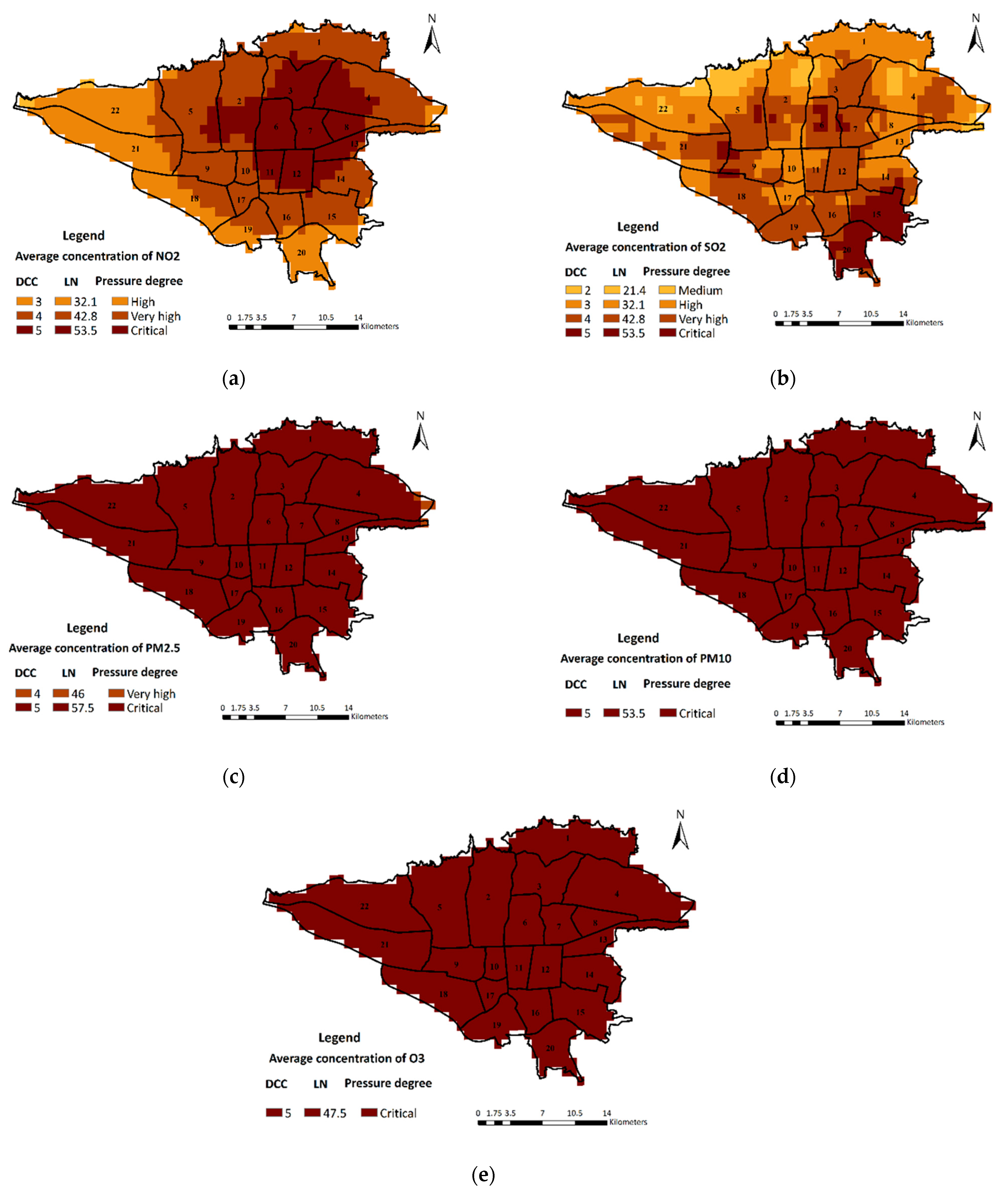
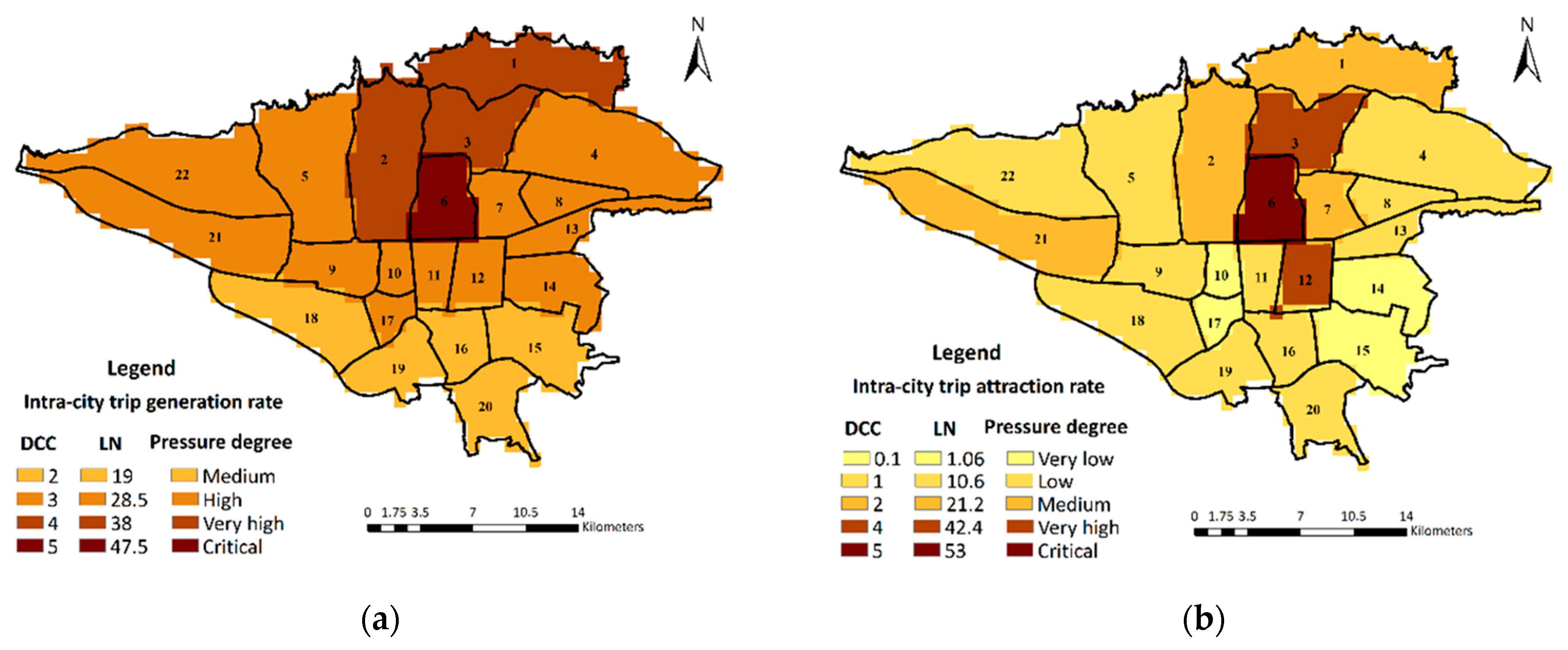
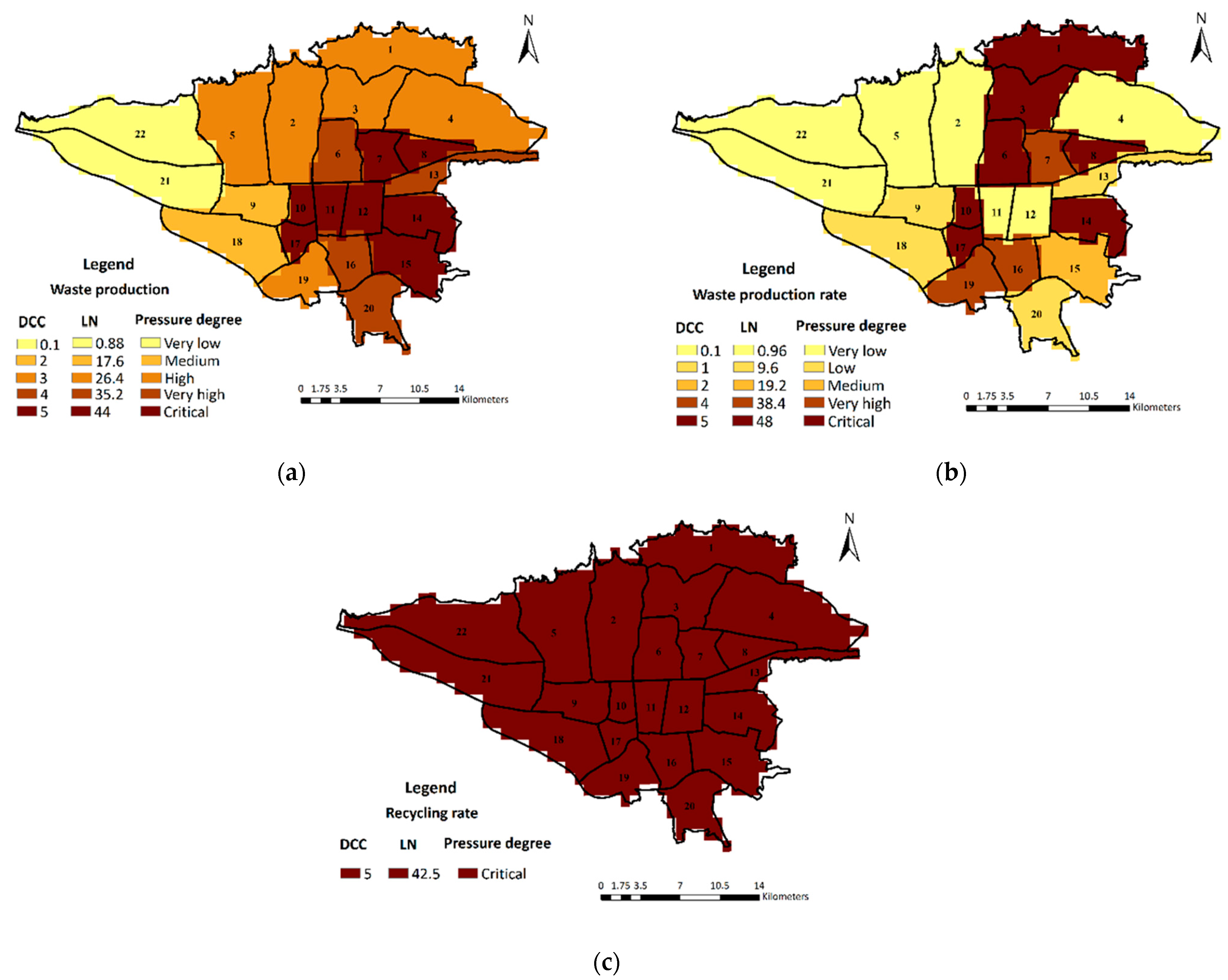

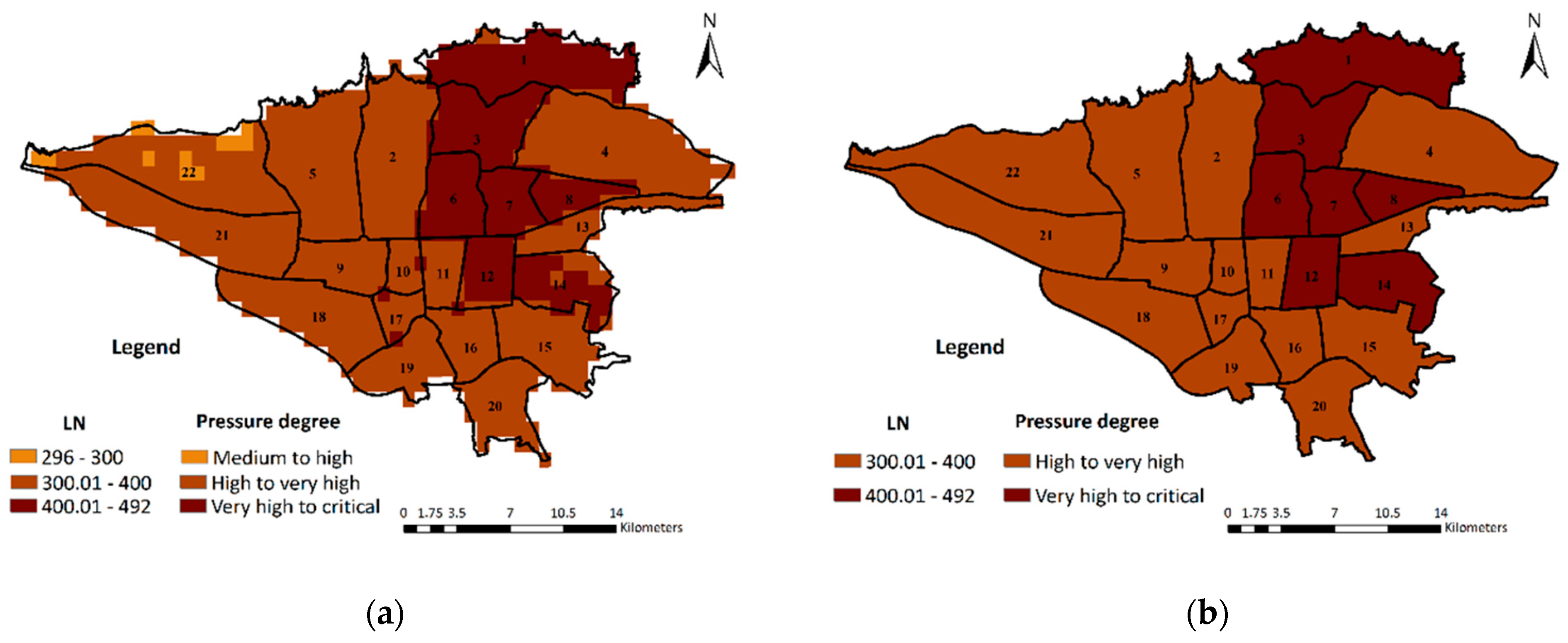
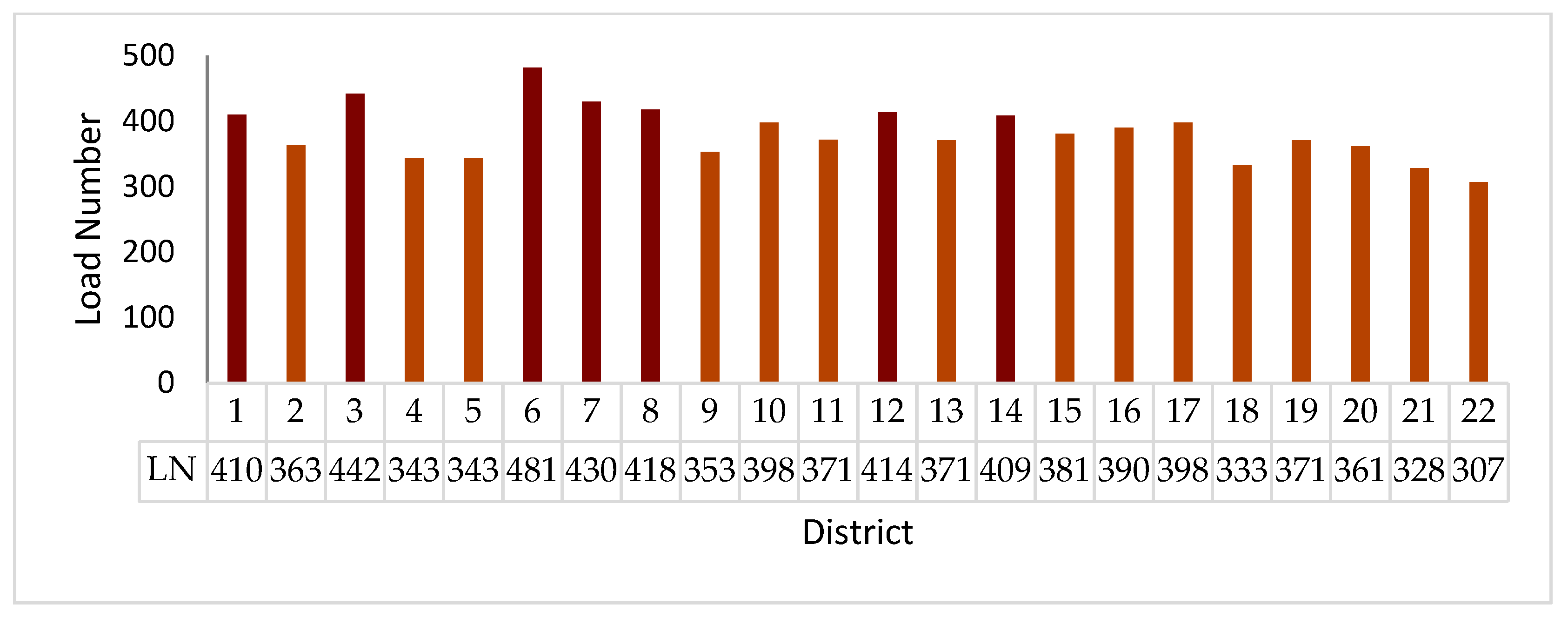
| Component | Indicator | Measuring Unit | Data Source | |
|---|---|---|---|---|
| air | average concentration of | NO2 | mol/m2 | [29] |
| SO2 | ||||
| PM2.5 | µg/m3 | [37] | ||
| PM10 | ||||
| O3 | ppb | |||
| traffic | intra-city trip | generation rate | number of trips per 100 m2 | [38] |
| attraction rate | ||||
| waste | waste production | ton/ha | [38,39] | |
| waste production rate | % | |||
| recycling rate | [40] | |||
| Class | 1 | 2 | 3 | 4 | 5 | 6 |
|---|---|---|---|---|---|---|
| DCC | 0.1 | 1 | 2 | 3 | 4 | 5 |
| pressure degree | very low | low | medium | high | very high | critical (exceeding the threshold) |
| meaning of DCC | desirable degree | degrees of pressure increasing from low to high | threshold degree | critical degree | ||
| Indicator | Measuring Unit | DCC (Pressure Degree) | ||||||
|---|---|---|---|---|---|---|---|---|
| 0.1 (Desirable) | 1 (Low) | 2 (Medium) | 3 (High) | 4 (Threshold) | 5 (Critical) | |||
| average concentration of | NO2 | µmol/m2 | 0–160.5 | 160.6–321 | 321.1–481.5 | 481.6–642 | 642.1–802.5 | 802.6–963 |
| SO2 | 0–65.5 | 65.6–131 | 131.1–196.5 | 196.6–262 | 262.1–327.5 | 327.6–393 | ||
| PM2.5 | µg/m3 | 0–5 | 5.01–10 | 10.01–15 | 15.01–20 | 20.01–25 | 25< | |
| PM10 | 0–15 | 15.01–20 | 20.01–30 | 30.01–40 | 40.01–50 | 50< | ||
| O3 | ppb | 0–15 | 15.01–31 | 31.01–32 | 32.01–33 | 33.01–36 | 36.01–51 | |
| intra-city trip | generation rate | number of trips per 100 m2 | 0–0.2–5 | 0.26–0.5 | 0.51–0.75 | 0.76–1 | 1.01–1.25 | 1.26–1.5 |
| attraction rate | 0–0.5 | 0.51–1 | 1.01–1.5 | 1.51–2 | 2.01–2.5 | 2.51–3.1 | ||
| waste production | ton/ha | 0–9 | 9.01–19 | 19.01–29 | 29.01–38 | 38.01–47 | 47< | |
| waste production rate | % | * | ||||||
| recycling rate | 80–100 | 65–79.99 | 50–64.99 | 35–49.99 | 20–34.99 | <20 | ||
| Rank | District | LN | Pressure Degree | Rank | District | LN | Pressure Degree |
|---|---|---|---|---|---|---|---|
| 1 | 6 | 481.4 | very high-to-critical | 12 | 11 | 371.2 | high-to-very-high |
| 2 | 3 | 441.8 | 13 | 13 | 371.0 | ||
| 3 | 7 | 429.8 | 14 | 19 | 370.6 | ||
| 4 | 8 | 418.1 | 15 | 2 | 363.1 | ||
| 5 | 12 | 413.7 | 16 | 20 | 361.4 | ||
| 6 | 1 | 409.9 | 17 | 9 | 353.3 | ||
| 7 | 14 | 408.5 | 18 | 4 | 342.9 | ||
| 8 | 10 | 397.9 | high-to-very-high | 19 | 5 | 342.9 | |
| 9 | 17 | 397.9 | 20 | 18 | 333.1 | ||
| 10 | 16 | 390.1 | 21 | 21 | 327.9 | ||
| 11 | 15 | 380.9 | 22 | 22 | 306.6 |
Disclaimer/Publisher’s Note: The statements, opinions and data contained in all publications are solely those of the individual author(s) and contributor(s) and not of MDPI and/or the editor(s). MDPI and/or the editor(s) disclaim responsibility for any injury to people or property resulting from any ideas, methods, instructions or products referred to in the content. |
© 2023 by the authors. Licensee MDPI, Basel, Switzerland. This article is an open access article distributed under the terms and conditions of the Creative Commons Attribution (CC BY) license (https://creativecommons.org/licenses/by/4.0/).
Share and Cite
Abbaszadeh Tehrani, N.; Farhanj, F.; Janalipour, M. Monitoring the Impacts of Human Activities on Urban Ecosystems Based on the Enhanced UCCLN (EUCCLN) Model. ISPRS Int. J. Geo-Inf. 2023, 12, 170. https://doi.org/10.3390/ijgi12040170
Abbaszadeh Tehrani N, Farhanj F, Janalipour M. Monitoring the Impacts of Human Activities on Urban Ecosystems Based on the Enhanced UCCLN (EUCCLN) Model. ISPRS International Journal of Geo-Information. 2023; 12(4):170. https://doi.org/10.3390/ijgi12040170
Chicago/Turabian StyleAbbaszadeh Tehrani, Nadia, Farinaz Farhanj, and Milad Janalipour. 2023. "Monitoring the Impacts of Human Activities on Urban Ecosystems Based on the Enhanced UCCLN (EUCCLN) Model" ISPRS International Journal of Geo-Information 12, no. 4: 170. https://doi.org/10.3390/ijgi12040170







